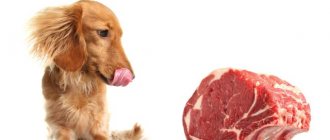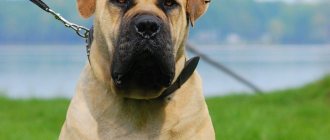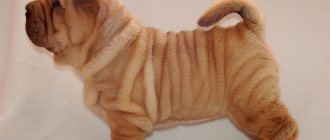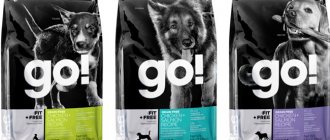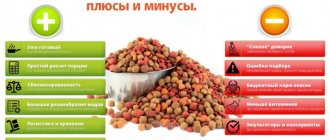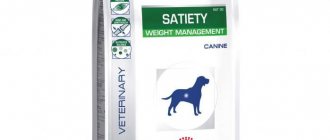Choosing a dry diet as the main food for dogs is a convenient, practical and affordable option that will simplify the life of the owner and maintain the health of the pet. It would seem that everything is simple, you just need to read on the packaging how much food to give your dog, measure out the required amount of dry granules and pour them into a bowl. In reality, many problems and questions arise. From the article you will learn: how the daily intake depends on the energy value and class of food, what to do if the dog does not eat enough of the recommended portion, how much water is needed and when it is necessary to review the amount of food given to the dog.
Should you feed your dog only prepared food or use a mixed diet?
Before we find out exactly what portion of dry food a dog needs every day, let’s find out whether it is possible to feed the dog exclusively with dry granules or canned food. Many owners worry that such a diet is too monotonous and can lead to negative consequences. To avoid this, they switch the pet to a mixed diet - mixing meat directly into a bowl of dry granules or replacing one of the meals with natural products.
Let's highlight the main risks that a dog's mixed diet carries:
- the combination of dry food and meat products can lead to excess protein. Its excess puts additional stress on the kidneys and liver. The result is kidney failure, liver dystrophy, allergic reactions;
- the combination of dry pellets and fish leads to an excess of phosphorus. The result may be urolithiasis. In addition, there is a critical decrease in the level of leukocytes. Minor hemorrhages appear. Bones lose calcium and accumulate phosphates. In adults this leads to osteoporosis, in children to rickets;
- a mix of dry food and porridge leads to an excess of carbohydrates in the body. This situation threatens the rapid development of obesity and all the ensuing consequences.
Constant menu changes actually terrorize the gastrointestinal tract, forcing it to produce different types of enzymes. Such intense work leads to gastritis and peptic ulcers.
Opponents of dry food talk about the risks that a monoration poses. First of all, they note a negative effect on the mucous membranes, especially when the daily norm is exceeded. Despite the qualitative differences in dry diets depending on the class to which they belong, there is no negative effect on the mucous membranes. Before entering the market, all dry food undergoes laboratory testing. All of them are produced with a monoration in mind, so high-quality products contain the entire necessary set of minerals, vitamins and microelements.
Important: of course, it is worth considering the presence of diseases in your pet. Particular attention should be paid to gastrointestinal problems. If a veterinarian recommends giving up dry food and switching to a natural diet, this must be done.
Why do you need to define the norm?
Determining the daily feeding rate is very important. Overfeeding or underfeeding will lead to health problems. Dogs cannot control their food intake on their own. Some breeds, such as pugs or dachshunds, will eat whatever is in their bowl. This behavior has a genetic reason - in nature, the ancestors of dogs did not get prey every day. Of course, domestic dogs are freed from the need to get their own food, but unlimited access to dry food leads to excessive consumption.
Interesting: some manufacturers put a special measuring cup in the package with dry food, which is very convenient for measuring portions for your pet. It is worth remembering that such measuring containers are only suitable for granules from a certain manufacturer and cannot be used for others.
Which variety should I choose?
The most common and common option is beef. It contains many useful elements and is not high in fat. Its use is completely safe for a dog that lives within the city. Many pets eat this kind of meat throughout their lives.
In addition to beef, dogs can be given the following varieties:
- Mutton. The daily portion should be limited, since meat is higher in calories. The optimal solution for herding and guard dogs. Lamb is very often chosen by shepherd dogs.
- Rabbit meat. Quite a dietary product that is recommended for small dogs. Not the best solution for constant use, which is associated with an increased amount of components that cause joint and kidney diseases.
- Veal. The meat is quite young, so it does not contain all the important enzymes. Excessively “empty” meat for the average pet.
- Horsemeat. A very easy option, which also should not be given daily. Many dogs do not like meat and frequent consumption of it can cause an allergic reaction.
- Venison. The most preferred option in the Far North, which is used instead of beef. The product contains a balanced set of elements.
- Bird. Turkey and chicken meat are often purchased as part of a diet or to save money. It is important to remove fat and skin, and remember that this is not the best option for dogs. The first reason is the use of hormones when raising poultry. The second is that chicken often contains parasite larvae.
- Giblets or offal. An ideal solution for variety, but cannot replace full-fledged meat. Often, pet owners choose unprocessed beef tripe.
Remember that feeding pork to dogs is not recommended. This is an excessively fatty product that contains almost no useful elements. The animal's stomach is not able to fully digest this meat, so you are simply throwing money away. In addition, the dog's health will suffer.
How to calculate the amount of food for a pet
Since we are talking about ready-made food rations: dry and wet, we will need to take as a basis tables with recommended daily intakes placed by manufacturers on food packaging. However, the owner will have to take into account a number of individual factors that distinguish his dog. These include:
- Age category of the dog (puppy, young or elderly dog);
- Weight (can be normal, overweight or underweight);
- Dog activity (number and duration of walks, physical activity during the day);
- State of health (presence of chronic diseases, pathologies);
- Physiological condition (pregnancy, lactating bitch, recovery from illness or surgery, and others).
The tables from the manufacturer indicate the recommended daily intake of dry food. Quite often they are significantly overestimated; manufacturers are simply not able to take into account all the characteristics of your pet.
It is necessary to collect all individual information about the dog and determine the brand of food for which the calculation will be made. It is better if dry food is selected by the owner together with a veterinarian, since it is not always possible to independently take into account all the medical contraindications of the animal. The use of a dry diet can lead to serious kidney problems and a serious allergic reaction - advice from a specialist in selecting food and determining the portion size is simply necessary.
What is meat for?
Although dogs have been around people for many years, they are carnivores, so protein is very important for replenishing nutrients and energy.
Dogs' bodies are excellent at digesting raw meat products. It is this food that has the most positive effect on them:
- Sharp and powerful molars and canines can be seen in the mouths of most small breeds, not to mention impressively sized dogs. Thanks to these “tools” they can crush and chew sinews and muscles.
- Abundant salivation and the high level of acidity of the large stomach contribute to the efficient digestion of raw meat without risk to health.
- The intestines are quite short, which indicates that the main element of the diet clearly cannot be cereals or herbs, since in this case the beneficial substances will not be able to be absorbed and enter the blood. In a healthy dog, the duration of a complete food digestion cycle is approximately 24 hours.
Almost all domestic and wild canid animals are ready to eat other types of food, including grains and vegetables. However, they act only as additional sources of nutrients, since the key part of the energy is provided by the main products.
Types of dog food
One of the most important indicators of dry food is its relationship to a certain class and the energy value of such a diet. There are types of dry food:
| View | Energy value (Kcal/100 g) | Compound | Recommendations | Example |
| Economy | 250-300 | Poor composition, based on grains and corn. Contains aromatic additives and dyes. A large portion is needed to satiate the dog. | Should not be used for regular feeding of dogs. Requires the use of additional vitamin and mineral complexes. | Chappie, Oscar, Meal, Favorite, Our brand, ProTail, Darling, Pedigree. |
| Premium | 300-350 | Higher protein content (about 20%), mainly due to offal and meat production waste. The composition contains vitamins and minerals, fiber. | Suitable for everyday nutrition, requires vitamin supplements adjusted for the physiological state of the dog. | Royal Canin, Brit Premium, Monge, |
| Super premium | 360-450 | The most balanced diet, with a minimum content or complete replacement of grains, a maximum content of meat (up to 75%). A complete complex of vitamins and minerals. | Suitable for daily feeding of dogs, no additional feeding is needed. | Akana, Eukanuba, Grandorf. |
| Holistic | 360-450 | Difference from the super premium class: the ingredients that make up the food are approved for use in the human food industry. | Maximum benefits, recommended for use in dog nutrition. | Landor, G.O., Canidae, Grandin. |
The daily amount is indicated by the manufacturer based on the normal physiological weight of the animal, and not the actual weight. If your dog weighs much more than is expected for a certain age, this is a reason to contact the veterinarian.
There is no direct relationship between the amount of dry kibble in your pet's bowl and how quickly he becomes satiated. A dog can eat a “bucket” of economy class pellets and remain hungry. Don’t think that buying low-grade food will save you money.
Pros and cons of straight women
Many people say that this style of feeding is much cheaper than purchasing commercially produced dry food. However, this is a misconception and this fact is only true under certain conditions. For example, when choosing exclusively premium options. Basically, reducing the cost of food is only possible for large breeds, because they usually eat a lot. With natural feeding, the main part will be taken up by various offal, spongy bones, vegetables and fruits.
Sometimes it takes patience to switch your pet to natural food, since at first he may refuse new food. But within 10 days or less, he will completely switch over to it.
There are also advantages:
- This diet is as close as possible to natural, that is, “wild”.
- The owner can clearly monitor the quality of the selected products.
- The menu is easy to change and vary daily, creating variety.
- This type of nutrition already contains the necessary amino acids, vitamins and minerals.
A similar system is perfect for allergy sufferers, because you can immediately eliminate the triggering product and never return to it. In industrial feeds, it is difficult to control the composition, even if it is indicated on the packaging. It’s not a fact that there isn’t something else there in small quantities.
There are also disadvantages:
- Spending extra time each day preparing food.
- More expensive products, especially when only those of high quality are selected.
- Frequent errors in calculating the quantity and ratio of products.
However, the main disadvantage is the problem when the owner leaves and the animal needs to be left in a special hotel or with friends/acquaintances. Hardly anyone wants to tinker with it, so most often it is transferred to industrial versions. After returning, you often have to start training your pet in a new way, and it is very good if such a “swing” does not lead to digestive disorders, allergies or gastrointestinal diseases.
Dry food
There are average feeding rates, according to which the daily dose is divided by the number of feedings. Most often, this standard is indicated in grams or in the number of measuring cups. 1 measuring cup = 240 ml (about 100 grams).
If necessary, dry granules can be softened with liquid: for puppies under 4 months of age, for older dogs or those with gastrointestinal problems.
I do this with different liquids depending on the dog’s preferences.
You should not prepare a large portion of soaked food, so as not to throw away an expensive product. Experts note that in the warm season, many animals refuse the softened product, preferring to drink dry granules with water.
Drinking regime for “dry feeding”
If the animal is fed only dry foods, then the required daily amount of liquid is calculated using the formula: 50 ml of water per kg of body weight.
Of course, you don’t need to give your dog water at certain intervals. She should have a free approach to drinking water and satisfy her own needs. And needs may vary depending on numerous conditions: age, physical activity, time of year, etc.
The water should always be clean - it needs to be changed every few hours. If this is not possible, a special automatic drinking bowl for dogs will come to the rescue. You should not use boiled water: the best option would be filtered or bottled water without gas. Raw water is strictly prohibited.
Rules for soaking dry food
If for some reason the amount of dry food is soaked, it is recommended to adhere to the following rules:
- use clean drinking water (can be bottled or filtered), but not boiled. Temperature - 40°C;
- The ratio of liquid to dry product depends on the preferences and age of the dog, and the manufacturer’s recommendations. Possible ratios (water:feed) - 1:2, 1:3;
- In addition to water, you can use low-fat fermented milk products - yogurt or kefir. The diluent should not be sweet, the temperature should be room temperature;
- the daily feed intake is not increased or decreased. Only the consistency of the portion changes.
Important: soaked dry food should be eaten within 2-3 hours. At any temperature, such food quickly sours and is inseminated by bacterial flora. If fermented milk products are used, it is necessary to carefully monitor the animal's stool. Minor liquefaction that resolves quickly should not cause alarm. If diarrhea continues for a long time, it is necessary to stop soaking dry food and consult a veterinarian.
The manufacturer may set a limit on the soaking of dry granules, which should be noted on the food packaging.
Photo: pixabay.com
Should the meat be cooked or raw?
Raw meat brings maximum benefit to animals, as it contains a lot of protein and important components. But don’t rush to give your dog fresh meat from the market stall.
Meat often contains dangerous microorganisms and parasite larvae. Therefore, it is better to pre-freeze it at a temperature of at least -15 °C. If this is not possible, it is recommended to boil the products. We must take into account that heat treatment kills part of the protein, so the amount of meat will have to be slightly increased.
Wet food
Soft canned food has exactly the same division into classes as dry food. This means that the higher the class of food, the greater its energy and nutritional value, which means that less of it will be needed to saturate.
However, it is not recommended to completely switch the animal to feeding canned foods - soft food can cause problems with the gastrointestinal tract, constipation or loose stools, and the risk of tartar formation increases, since there is no mechanical cleaning of plaque.
| Type of dog | Daily calorie requirement (kcal) | Combined diet (dry + wet) (g) Pedigree | Only wet (100%) (gr) Using Pedigri as an example |
| Miniature (2-5 kg) | 250-350 | 40-50 | 300-400 |
| Small (6-10 kg) | 360-550 | 50-100 | 400-700 |
| Medium (12-24 kg) | 600-1050 | 100-250 | 800-1300 |
| Large (26-40 kg) | 1100-1550 | 200-300 | 1400-2000 |
| Very large (45+ kg) | 1600-2500 | 300-550 | 2050-6000 |
Conclusion
Natural nutrition is as close as possible to the dog’s diet in its natural habitat. Therefore, if you have the time and desire, you can always create a balanced and healthy diet for your pet, which will be the key to your dog’s health and longevity.
By the way, if you decide to switch your pet from natural feeding to dry food, you need to do this gradually, over 10-14 days. At the same time, during the transition period, probiotics should be added to the dog’s diet daily.
Daily food intake for puppies
| Puppy age (in months) | Number of meals per day | Daily kcal norm per 1 kg of weight in |
| Up to 1 | 6 | 220-250 |
| 1-3 | 5 | 260-280 |
| 3-4 | 4 | 200-230 |
| 4-8 | 3-4 | 120-150 |
| 8-12 | 2-3 | 100-130 |
Small breeds of puppies
Puppies of small and miniature breeds develop very quickly due to increased metabolism; at 6 months, such a miniature dog puppy is already very similar to an adult dog. Therefore, during the period of intensive growth, such babies need high-calorie food, which allows the animal’s body to properly form in such a short time.
| Age\weight (months) dog weight up to 10 kg | Super premium diet (using Akana as an example, value about 450 kcal) | Economy (using the example of Our Brand, value about 300 kcal) |
| 1-3 | 15-80 gr | 45-100 gr |
| 3-4 | 17-115 g | 60-200 gr |
| 4-6 | 20-120 gr | 70-250 gr |
| 6-12 | 25-125 gr | Feed used for adult animals |
Photo: flickr.com
Large breeds of puppies
Large breed dog puppies need a diet rich in protein and calcium for muscle growth and healthy skeletal development. Their development occurs spasmodically, at six months of age they look more like ugly ducklings rather than adult dogs. The heart muscle also requires special nutrition, which must receive all the necessary elements for further uninterrupted operation.
| Dog's age/weight | Super premium diet, value 400 kcal (using Grandorf as an example) | Economy food, value 300 kcal (using the example of Pedigree) |
| 1-3 (from 5 to 70 kg) | 50-220 gr | 400 gr |
| 3-4 (from 25 to 70 kg) | 230-330 gr | 450-530 gr |
| 4-6 (from 25 to 70 kg) | 260-500 gr | 550-600 gr |
| 6-12 (from 25 kg) | 250-800 gr | 650-900 gr |
Approximate daily diet for a dog
Creating a balanced diet for a dog is not as difficult as it might seem at first glance. Let's look at what a sample menu for a four-legged pet looks like.
Morning feeding
The ideal solution would be fermented milk products (yogurt, fermented baked milk, kefir, cottage cheese or sour cream) combined with a small amount of porridge. Be sure to add vegetables to the finished porridge.
Evening feeding
Porridge with meat broth, as well as the daily allowance of meat. Additionally, you can give your pet vegetables or fruits. Meat should be replaced with fish 1-2 times a week.
Also, boiled chicken eggs (1 piece each) should be added to the evening feeding a couple of times a week. Or raw quail (3-4 pieces each).
This is important: Veterinarians recommend not mixing meat and dairy products in one feeding. And also do not give fish and meat at the same time.
Daily food intake for adult dogs
| Normal dog weight (kg) | Norm of dry granules per day (g) with normal activity | Norm for high animal activity (in g) |
| 1.5-6 | 50-110 | 100-200 |
| 6-10 | 115-150 | 215-290 |
| 10-16 | 155-230 | 300-410 |
| 16-23 | 235-290 | 420-550 |
| 23-35 | 295-400 | 560-630 |
| 36-45 | 410-500 | 700-900 |
| 45+ | 510 + 50 g/ 5 kg weight | 800 + 100 g\ 5 kg weight |
For a pregnant bitch, the daily intake of an adult dog (by weight) is increased by 25-50% depending on appetite, in consultation with a veterinarian. It may be worth giving up food intended for adult dogs and using a diet for puppies. A portion of such food is calculated according to the rule: the daily norm of an adult healthy individual with normal activity + 25-50%.
How to determine the weight for one serving
There are several ways to determine portion weight.
- Weighing. After placing a certain amount of granules in a bowl, place it on the scale and record the result. Remove/add granules as needed. Don't forget to take into account the weight of the bowl.
- Using dispensers. You can purchase suitable measuring spoons or glasses and use them to measure the required portion weight.
- Determination by eye. It is acceptable if you have fed the animal several times and can imagine how large the portion given looks like.
Daily food intake for older dogs
Upon reaching the age of seven, the pet needs to review its diet and the amount of food consumed. During this period, chronic diseases and pathologies worsen, and metabolism slows down. The dog needs additional minerals, but not an increase in food portions. It is worth changing the food, choosing one that contains special markings.
Let us note that with age, most animals’ need for rest and sleep increases, but food preferences change greatly: from uncontrolled food consumption to refusal of it.
If your dog has problems with the gastrointestinal tract or teeth, you should start soaking the granules or switch to wet canned food.
| Dog weight (over 7 years old) in kg | Daily value (in g) | Daily value in a cup (1 measuring cup about 100 g) |
| 1,5-5.5 | 35-100 | 1\3-1 |
| 5,5-9,5 | 110-150 | 1-1,5 |
| 10-15 | 160-210 | 1,5-2 |
| 16-23 | 220-300 | 2-3 |
| 24-35 | 310-380 | 3-3,5 |
| 36-45 | 390-470 | 4-4,7 |
| 45+ | 480 + 50 g/ 5 kg | 5+ |
How many times a day
There is no special rule about this, and the number of meals will directly depend on age:
- Up to 3 months – 5-6 times.
- From 3 to 6 – 4 doses.
- More than 6 – 3 times.
Starting from 12 months, the animal is considered mature, so it is better to switch to two meals a day. Adults are fed in the same way throughout their lives.
How much water does a dog need when eating dry food?
Water is the basis for proper digestion and metabolism. In order for your dog’s body to receive all the necessary substances from their dry food, you must strictly follow the rules for providing it with water:
- The daily water intake depends on the dog’s weight and the portion of dry food consumed;
- For 1 kg of animal weight, about 40-60 ml of water is required;
- Puppies need more fluid - about 80-100 ml per kg;
- Monitor your pet's behavior - if he eats exclusively dry food, he may need more water than normal;
- If the ambient temperature drops below +20, the dog can reduce its fluid intake.
A bowl of clean, fresh water should always be available to your dog. Monitor your fluid intake - deviations from normal behavior should alert you and this is a reason to consult a doctor. Don't get dehydrated!
Photo: wikimedia.org
How to feed
The basis of a pet's diet should be unprocessed ingredients of natural origin. Since in the wild our pets are predators, most often it is muscle meat and bones up to 80% of the total amount of food consumed per day. 10% should be allocated for offal (liver, kidneys, etc.) and 10-20% for vegetables and fruits.
There are three main pillars of feeding that should not be forgotten:
- It is undesirable and even harmful to mix canned or dry food with natural food. The animal's stomach gets used to it and secretes certain enzymes in specific quantities. Adding something else can cause indigestion at best, and at worst have a negative impact on the gastrointestinal tract as a whole.
- Giving porridge is unproductive. So the pet will not receive vitamins, macro- and microelements that are needed for normal growth and vital functions. Then, without fail, you will have to add pharmaceutical complexes to the menu in order to avoid problems with teeth and hair.
- In order to switch your pet to a natural diet for dogs, food and products for which are not heat-treated, it is not necessary to visit a veterinarian (if there are no health problems, of course). For a safe transition you need to follow special instructions.
Prohibited positions
The transition to natural food will require special attention from the owner so that the experiments do not cause histamine reactions, gastrointestinal diseases or health problems. Therefore, first you should decide on a list of what it is definitely not recommended to give:
- Grape.
- Garlic.
- Macadamia.
- Nuts and dried fruits.
- Raw potatoes.
- Milk.
- Chocolate.
- Pickles and smoked dishes.
- Alcohol.
- Yeast baked goods.
- Sweets.
- Trimmed fat.
- Raw river fish.
- Chicken bones.
- Pork.
Allowed
Proper nutrition is the key to good, good health and an attractive appearance, this is equally true for people and animals. Food will have to be chosen extremely carefully, paying attention to all factors: freshness, quality, naturalness. The list of acceptable products is quite diverse:
- beef;
- chicken;
- turkey;
- duck;
- carrot;
- beet;
- broccoli;
- cauliflower;
- zucchini;
- apples;
- pears;
- vegetable oils.
Most owners do not raise meat poultry and animals at home specifically to feed their pet, so the selection of meat delicacies must be approached carefully. It is best to purchase them from trusted sellers at the market or in a store in order to get meat that is truly free from diseases or helminths.
The basic principle of the BARF nutrition system is proportions.
Dog food formula:
- up to 70% muscle meat,
- 10% raw bones (no meat),
- 5% liver,
- up to 5% of other organs (for example, kidneys, pancreas, etc.),
- from 10 to 20% fruits and vegetables.
Dogs, unlike cats, need more crude fiber to form a prebiotic environment. Therefore, their diet should include vegetables and unsweetened fruits. SUPERPET contains apple, carrot, pumpkin and spinach. These products go well with meat components. Indigestible dietary fiber (prebiotics), undergoing slow fermentation, not only serves to cleanse the body, but also regulates the beneficial intestinal microflora, being a nutrient substrate for beneficial bacteria and negating the possibility of stagnation.
Prebiotics are indigestible dietary fiber. During the fermentation process, they cleanse the body, create and regulate beneficial intestinal microflora.
If the dog does not eat enough dry food
All these rather complex and sometimes inaccurate calculations are needed to ensure that the dog does not starve and receives the maximum amount of nutrients from the food it eats. Of course, if a dog is constantly begging for treats and food from the owner’s table, this does not mean that the portion of food is not enough for him. However, you should carefully ensure that the offered portion is enough. Symptoms of deficiency may include:
- after feeding, the dog does not leave the bowl, freezes, waiting for more;
- the dog’s ribs, pelvic bones and scapular edges are clearly visible;
- the hunger pit is pronounced;
- the fat layer is thin.
These signs indicate that the dog is underweight. This can be either a consequence of the disease or insufficient nutritional value of the daily diet. In this case, the owner must:
- Visit your veterinarian to rule out your pet losing weight as a result of illness. For example, infections with parasites;
- if the dog receives super premium or holistic food, it is worth increasing the portion. Perhaps the animal’s physical activity has increased, its physiological state has changed, the cold season has arrived - all these are reasons to increase the proportion of dry granules in the bowl;
- if feeding is carried out with a diet of a lower class, choose higher quality, high-calorie and energy-rich dry food. It is better to choose an option, buying it in small packages in order to choose exactly what your dog will like;
- You can switch your dog to a mixed diet according to the following scheme: wet canned food + dry granules. Canned food is more nutritious and is often more appealing to animals.
Vitamin supplements and complexes
Among natural ingredients, it is recommended to use fish oil, raw seaweed, crushed eggshells, wheat germ flour and brewer's yeast. These popular sources of vitamins normalize intestinal microflora, strengthen bones and improve coat quality.
The amount of vitamin the animal needs is clarified by the veterinarian after testing. In addition to the options listed, you can choose vitamin complexes in tablet form. They will help balance the amount of useful elements not received from food.
Why is underfeeding bad?
If exceeding the norm threatens obesity, then what is wrong with underfeeding? A deficiency of nutrients that the dog does not receive from the daily diet will have a bad effect on the dog’s health - the animal’s bones and internal organs will suffer. This is especially true for pregnant and lactating bitches. Underfeeding is dangerous for a puppy or a bitch that has just given birth.
During the period of feeding puppies, the feeding rate is increased - in this case, the food can be left in the animal’s bowl without restricting it. Even if she eats 200% of her daily allowance, that's okay. Malnutrition threatens not only the deterioration of the health of the mother with a tail, but also of the puppies, since the quality of milk decreases.
Important: if during the feeding period the bitch cannot eat a lot of food, and she loses weight, it is worth consulting a specialist. It would be better to switch the animal to a higher-calorie type of dry food.
How to cook dog porridge with meat
From experience, we can say that for proper nutrition, you need to feed your dog porridge with meat 2-3 times a week. Pearl barley, oatmeal, and wheat porridge will bring benefits, but buckwheat is the most beneficial. It contains many useful minerals, and besides, it helps the dog lose weight and cleanses the circulatory system.
Therefore, next we will describe the process of preparing buckwheat dog porridge. Preparing such a dish is not difficult. In the evening, pour cold water over buckwheat and leave overnight. To cook porridge, you will need to take 1 part buckwheat and add 2 parts water. This porridge is cooked for 15 minutes, after which it is infused in the pan for the same amount of time.
During the cooking process, you can add chopped meat to the porridge. Before adding to the porridge, the meat must be boiled to prevent possible infection of your pet. The total volume of meat should be approximately 1/3 of the volume of porridge.
Many dogs love to crunch on cucumbers.
As for additives and seasonings, it is advisable to avoid adding salt to porridge, but a teaspoon of vegetable oil will be very useful.
Briefly about the main thing
- Super premium and holistic dry food is best suited for feeding a dog;
- Dry food is digested much faster than natural food - it is worth feeding the animal three times a day in small portions, dividing the daily intake by the number of feedings;
- The dog’s diet should be based on its age, weight, health status and other individual characteristics;
- You can combine dry granules and wet canned food;
- The manufacturer provides the recommended serving size, it is a guideline;
- Small and large breed dogs have different nutritional needs;
- The dog should always have clean, fresh water available.
How do you calculate the required portion of food for your pet? Which food was chosen: economy or super premium? What differences in serving size have you seen? Share your experience in the comments to the article, please. Your opinion is very important to us.
Required amount of food
It is not difficult to deal with this issue. Just watching is enough. If the bowl is regularly not completely emptied after feeding, you need to cut back on the portion. And when the dog licks the plate and asks for more, you should add a little. On average, a healthy animal requires a certain amount of:
- 5-7% of body weight for a puppy.
- 2-5% of the total weight for an adult.
For an average-sized dog (12-15 kilograms), the portion will vary between 450-600 grams at a time. Regular overfeeding leads to obesity, the development of health problems and various diseases. We suggest calculating your individual feeding rate using a special calculator.
Useful tips
We have given all the necessary information to create the right diet. In conclusion, here are some more useful tips:
- Take raw materials from trusted sellers; farms and meat depots are best suited.
- Always cook or freeze the product.
- Do not overfeed your pet.
- The rules for calculating portions apply to an adult healthy dog; for a working or pregnant dog, the amount of food is increased; for domestic and elderly dogs, it is reduced.
- Never leave food in a bowl; your pet should eat everything until the end.
Natural food is as close as possible to the natural living conditions of animals. If you are willing to put in the time and effort, you can create a balanced, healthy diet that will ensure your pet’s excellent health.
